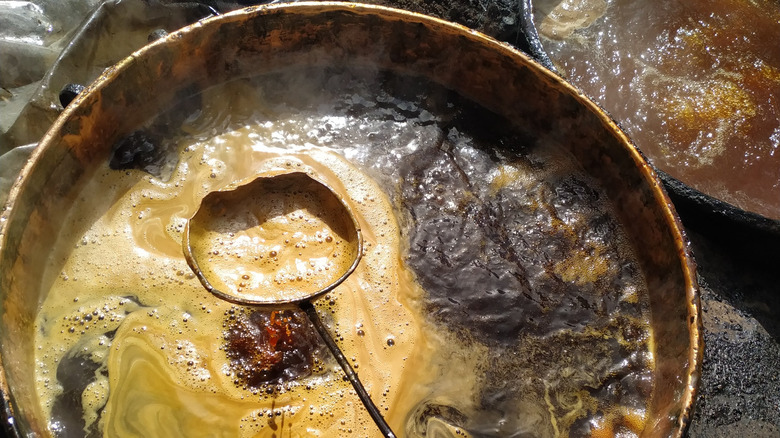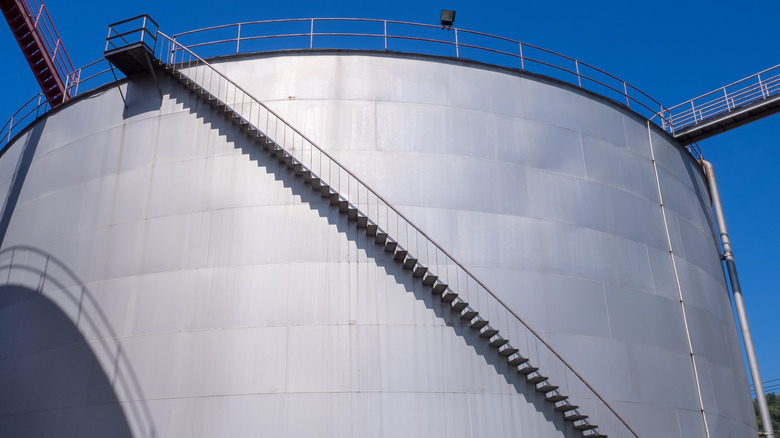Why 2 Million Gallons Of Molasses Once Took Over Boston
While it may seem appealing to walk into a home that has the sweet smell of molasses in the air, in Boston's North End on January 15, 1919, that aroma was the consequence of a devastating catastrophe unfolding in the city (via Boston Magazine).
The streets of the city's oldest residential area were filled with workers and others enjoying the unseasonably warm 40-degree weather when a tank filled with over 2 million gallons of molasses burst at its seams, according to Science Alert. As rivets flew off of the exploding tank, a 35-40 foot high viscous wave of the sweet substance spilled out and took over two blocks of the town, moving at 35 miles per hour and dragging debris, animals, and humans along with it.
With buildings knocked off of their foundations, the elevated train track severed, 21 people dead, and at least 150 injured, the neighborhood was devastated. It was nearly six months before the area returned to a semblance of normalcy but the smell of molasses, especially on warm days, remained for decades (per Boston.com).
What caused Boston's Great Molasses Flood of 1919?
The molasses-filled tank that ruptured belonged to the United States Industrial Alcohol Company (USIAC) which had primarily processed the molasses for the purpose of providing industrial alcohol to makers of munitions during World War I (via History). The tank itself was crafted quickly in 1915, at the war's height. In the haste to create what would become the city's largest tank at the time, the company overlooked what should have been standard safety procedures like testing the tank by filling it with water. The tank's steel also lacked manganese, making it very brittle in cold temperatures.
Worse, USIAC turned a blind eye to obvious signs that the tank was compromised. Reports from workers say that when filled, the tank groaned audibly. Local children frequently took cups to the tank and collected molasses that leaked down the side. Showing a complete lack of concern, the company deceptively attempted to conceal the dripping molasses by painting the tank a shade of brown, according to Boston Discovery.
Instead of owning up to their failure to follow proper protocol after the disastrous tank failure and ensuing flood, USIAC instead alleged that anarchist terrorists dropped a bomb into the tank, according to Stephen Puleo, author of "Dark Tide" (per Boston Magazine). Police investigations quickly proved the company's claims false. The company was ultimately found negligent and was forced to pay $628,000 ($9.2 million today) to victims and their families (via Science Alert).
Temperatures worsened the situation
In addition to the structural failings of the tank that caused it to rupture and spill the molasses, the temperatures also contributed to the catastrophe. Daytime temperatures in the 40s allowed the molasses to flow more freely while the chilly nighttime temps thickened it after the sun went down, slowing the ability of first responders to reach trapped and injured individuals (via Britannica). As night set in and colder temperatures descended on the city, people who were already trapped by debris were in a worsening situation as the liquid thickened, according to Nicole Sharp, an aerospace engineer in Denver (via History).
"Temperatures dipped just below freezing the night following the accident. Based on our data, it's possible the viscosity of the molasses increased by a factor of four or more due to that drop in temperature. That does not sound like such a big difference, but the high viscosity of the molasses was a major factor for rescue work," Sharp told Live Science.
While the temperatures on that January afternoon in Boston contributed to the catastrophe, it was ultimately a failure in judgment and ethics that led to the death and destruction that occurred that day.


